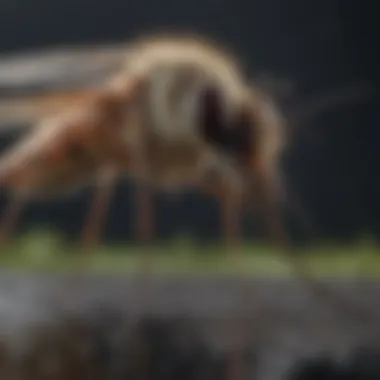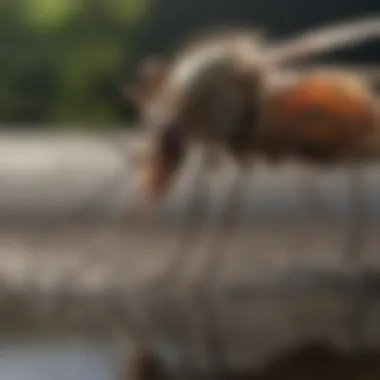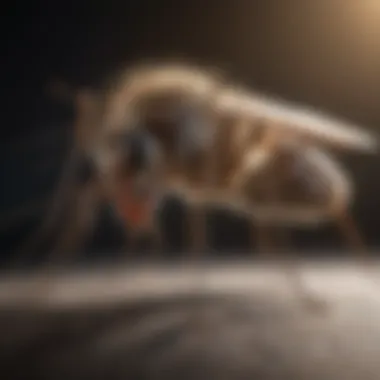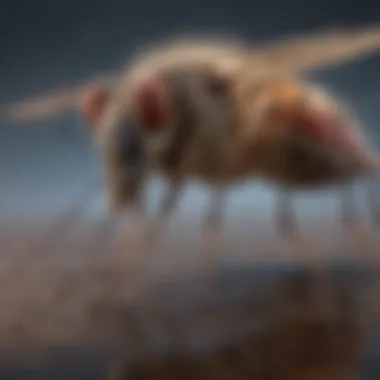Revolutionizing Mosquito Control: The Ultimate Guide to Mosquito Abatement Systems Unveiled


Preventive Pest Control Strategies
When it comes to keeping pesky insects and unwanted critters at bay, preventive pest control strategies play a pivotal role in maintaining a pest-free environment within your home. To start, focusing on protecting the exterior of your house is key. Sealing cracks and gaps in your walls and foundation can significantly reduce the entry points for pests. Additionally, clearing away debris such as leaves, branches, and other clutter around your property eliminates potential hiding spots for pests. By preventing pests from gaining easy access to your home, you can proactively ward off infestations and protect your living space.
Incorporating yard maintenance into your routine is another crucial aspect of preventive pest control. Regularly mowing the lawn, trimming vegetation, and removing standing water helps in deterring mosquitoes, flies, and other insects that thrive in unkempt outdoor spaces. By implementing essential yard care routines, you can create a less hospitable environment for pests, reducing the likelihood of infestations.
Maintaining a clean indoor space is equally important in pest prevention. Following expert cleaning tips and techniques like vacuuming regularly, storing food in airtight containers, and sealing cracks and crevices in cabinets can help in keeping common household pests such as ants and cockroaches at bay. By creating a pest-resistant indoor environment, you significantly decrease the chances of pest infestations taking root.
Effective garbage disposal practices can also play a significant role in pest prevention. Properly sealing trash bags, emptying bins regularly, and keeping outdoor garbage containers tightly closed can prevent attracting pests like rodents and flies to your property. Ensuring efficient waste disposal methods are in place not only keeps your surroundings clean but also minimizes opportunities for pests to thrive.
In addition to the above strategies, exploring innovative ways to safeguard your home against pests is essential. From utilizing natural repellents and deterrents to implementing technological advances like smart pest control devices, there are various modern approaches to pest prevention worth considering. By adopting a comprehensive approach that integrates these preventive pest control strategies, you can create a pest-resistant environment that promotes a healthier and more comfortable living space.
Introduction
In the world of pest management, mosquitoes pose a significant threat due to their ability to transmit diseases and disrupt ecosystems. This article delves deep into the realm of mosquito abatement systems, unveiling the innovative technologies and strategies that are reshaping how we approach mosquito control. By understanding the biology of mosquitoes and exploring cutting-edge methods, we gain insight into the holistic view of how these systems are revolutionizing pest management practices.
Understanding the Mosquito Problem
Evolutionary Adaptations of Mosquitoes
Mosquitoes have evolved various adaptations over time, making them formidable adversaries in the realm of pest control. Their ability to breed rapidly and develop resistance to traditional control methods presents a challenge to effective mosquito management. Understanding these evolutionary traits is crucial in devising comprehensive control strategies to combat mosquito populations. While their resilience may pose obstacles, it also underscores the necessity for innovative and adaptive mosquito abatement systems.
Impact of Mosquito-Borne Diseases
Mosquito-borne diseases have a significant impact on public health, causing illness and mortality worldwide. Diseases such as malaria, dengue fever, and Zika virus are transmitted through mosquito bites, leading to widespread health crises. By comprehending the gravity of these diseases, the urgency of implementing effective mosquito control measures becomes evident. The impact of mosquito-borne illnesses emphasizes the critical role of mosquito abatement systems in safeguarding human health and well-being.
Ecological Importance of Mosquitoes
Despite their reputation as pests, mosquitoes serve important ecological functions within ecosystems. They act as pollinators and a food source for various species, contributing to the delicate balance of biodiversity. Recognizing the ecological significance of mosquitoes highlights the complexity of mosquito control efforts. Balancing the need to manage mosquito populations with preserving their ecological role underscores the multifaceted considerations involved in implementing mosquito abatement systems.
The Necessity of Mosquito Control
Health Risks Posed by Mosquitoes
Mosquitoes pose significant health risks by transmitting a myriad of diseases to humans and animals. From malaria to West Nile virus, these diseases can have severe consequences on individuals and communities. Understanding the health implications of mosquito-borne illnesses underscores the critical importance of proactively addressing mosquito populations. By mitigating these risks through effective control measures, we aim to reduce the burden of mosquito-related health issues.
Environmental Concerns
The use of conventional mosquito control methods such as chemical insecticides raises valid environmental concerns. These chemicals can impact non-target species, disrupt ecosystems, and lead to long-term environmental damage. Recognizing the environmental implications of mosquito control practices is essential in developing sustainable and eco-friendly solutions. Addressing these concerns through innovative approaches ensures that mosquito abatement systems align with environmental conservation efforts.


Social and Economic Implications
Mosquito-borne diseases not only have health implications but also significant social and economic repercussions. Outbreaks of diseases like dengue fever can strain healthcare systems and hinder economic productivity in affected regions. By considering the broader social and economic implications of mosquito control, we underscore the interconnectedness of public health, social well-being, and economic prosperity. Implementing effective mosquito abatement systems is not only a health priority but also a social and economic imperative.
Introduction to Mosquito Abatement Systems
Definition and Objectives
Mosquito abatement systems are designed to reduce mosquito populations and mitigate the risk of mosquito-borne diseases. These systems encompass a range of control methods and technologies aimed at limiting mosquito breeding and activity. Understanding the definition and objectives of mosquito abatement systems is fundamental in grasping their purpose and effectiveness in pest management. By aligning with clear objectives, these systems can target mosquitoes efficiently and minimize their impact on public health and ecosystems.
Evolution of Mosquito Abatement
The evolution of mosquito abatement practices reflects the continuous refinement and adaptation of control strategies over time. From traditional methods to cutting-edge technologies, the evolution of mosquito abatement underscores the drive for innovation in mosquito control. By tracing this evolution, we gain insights into the progression of mosquito control techniques and the advancements that have led to more effective and sustainable approaches. Embracing the evolution of mosquito abatement systems paves the way for enhanced mosquito management practices that cater to present and future challenges.
Types of Mosquito Abatement Systems
In the realm of mosquito abatement systems, understanding the different types plays a crucial role in effectively combating mosquito populations. This section dives into the varied approaches utilized to control mosquitoes, highlighting their specific benefits and considerations within the context of this comprehensive guide to revolutionizing mosquito control.
Biological Control Methods
Introduction to Biological Agents
Exploring the realm of biological control methods unveils the strategic use of natural agents to curb mosquito populations. Biological agents are organisms utilized to control pests like mosquitoes, presenting a sustainable and eco-friendly alternative. Their key characteristic lies in their ability to specifically target mosquito larvae or adults, ensuring a precise and effective control method. This section delves into the benefits of using biological agents, emphasizing their non-toxic nature and minimal impact on the environment. While advantageous in reducing mosquito populations, drawbacks may include specific environmental conditions that impact their efficacy.
Implementation of Biological Control Measures
The implementation of biological control measures involves the strategic application of these agents in mosquito-prone areas. This approach contributes significantly to the overall goal of reducing mosquito populations and minimizing the need for chemical insecticides. The key characteristic of this method lies in its sustainable and long-term effectiveness, providing a natural solution to mosquito control. By harnessing the unique features of biological agents, such as Bacillus thuringiensis israelensis (Bti) or predatory fish, this method proves advantageous in targeting specific mosquito species without harming beneficial organisms. However, challenges may arise in ensuring proper application and monitoring to maintain control efficacy.
Chemical Control Strategies
Insecticides and Larvicides
Chemical control strategies involve the use of insecticides and larvicides to curb mosquito populations swiftly and effectively. Insecticides and larvicides target mosquitoes at various life stages, disrupting their growth and reproductive cycles. The key characteristic of these chemicals is their rapid knockdown effect on mosquito populations, offering a quick solution to immediate mosquito infestations. The use of insecticides and larvicides is a popular choice due to their proven effectiveness in reducing mosquito-borne diseases. However, their unique feature of chemical toxicity raises concerns about potential harm to non-target species and the environment.
Residual Spraying Techniques
Residual spraying techniques establish a protective barrier against mosquitoes by applying insecticides to surfaces where mosquitoes rest. This method contributes significantly to controlling adult mosquito populations in domestic and peridomestic settings. The key characteristic of residual spraying lies in its long-lasting effects, providing continuous protection against mosquitoes for an extended period. The unique feature of residual spraying techniques is their ability to target indoor resting sites of mosquitoes, reducing human-mosquito contact. Despite its advantages in immediate mosquito control, challenges may arise in resistance development and potential environmental contamination.
Technological Advancements in Mosquito Control
Utilization of Drones and Sensors


Embracing technological advancements, the utilization of drones and sensors brings a high-tech approach to mosquito control. Drones equipped with sensors and cameras enable aerial surveillance of mosquito breeding grounds, enhancing control efforts. The key characteristic of this technology is its ability to provide real-time data on mosquito populations and breeding habitats, aiding in strategic decision-making. The unique feature of drone technology lies in its precision targeting of mosquito-prone areas, ensuring accurate deployment of control measures. Despite its numerous advantages in efficiency and data collection, challenges may emerge in initial setup costs and operational complexities.
Precision Targeting Systems
Precision targeting systems leverage cutting-edge technology to accurately identify and control mosquito populations. By utilizing data-driven approaches and GPS technology, precision targeting systems can pinpoint high-activity mosquito areas with precision. The key characteristic of this system is its ability to streamline control efforts, maximizing the impact on mosquito populations while minimizing off-target effects. The unique feature of precision targeting lies in its tailored approach to mosquito control, optimizing resource allocation and efficacy. Despite its advantages in accuracy and efficiency, challenges may surface in data interpretation and system calibration.
Integrated Mosquito Management Approaches
Combining Various Control Methods
Integrated mosquito management approaches integrate multiple control strategies to enhance overall efficacy. By combining biological, chemical, and technological measures, this approach offers a comprehensive solution to varying mosquito populations and environmental settings. The key characteristic of this approach is its synergistic effect, utilizing the strengths of each method to overcome individual limitations. The unique feature of integrated management lies in its adaptability to different mosquito control scenarios, providing a holistic and sustainable approach. While advantageous in addressing diverse mosquito challenges, challenges may arise in coordinating multiple control methods and ensuring seamless integration.
Community Engagement and Education
Community engagement and education play a pivotal role in fostering support for mosquito control efforts and promoting sustainable practices. By educating communities on mosquito biology, prevention methods, and the importance of mosquito abatement, individuals can actively contribute to control initiatives. The key characteristic of community engagement lies in its ability to mobilize collective action and empower communities to take ownership of mosquito control. The unique feature of educational campaigns is their long-term impact on changing behaviors and reducing mosquito breeding sites. While beneficial in creating a sense of responsibility and awareness, challenges may emerge in maintaining community involvement and sustaining educational programs.
Implementing Mosquito Abatement Systems
In the realm of mosquito control, implementing effective abatement systems is pivotal to managing and reducing mosquito populations. This section of the article delves deeply into the core strategies and technologies used to combat these disease-carrying pests. By focusing on implementing mosquito abatement systems, we aim to provide a comprehensive insight into the essential elements, benefits, and considerations vital in revolutionizing pest management practices.
Planning and Surveillance
Risk Assessment
Risk assessment plays a crucial role in the overall strategy of mosquito abatement systems. It involves identifying potential risks associated with different control methods and environments, thus allowing for informed decision-making to mitigate these risks effectively. One key characteristic of risk assessment is its proactive nature, enabling prevention rather than reaction. This proactive approach is beneficial in ensuring that control measures are not only effective but also environmentally sustainable. The unique feature of risk assessment lies in its ability to prioritize control strategies based on risk levels, optimizing resources for maximum impact. While risk assessment is invaluable in guiding decision-making in mosquito abatement, some challenges include the complexity of risk evaluation and the need for continuous monitoring and reassessment to adapt to evolving circumstances.
Monitoring Mosquito Populations
Monitoring mosquito populations is fundamental in understanding their dynamics and assessing the effectiveness of control measures. By tracking population levels, species distribution, and insecticide resistance, we can tailor control strategies for optimal outcomes. The key characteristic of monitoring mosquito populations is its ability to provide real-time data, allowing for immediate adjustments to control efforts. This real-time feedback loop is advantageous in optimizing the timing and targeting of interventions. A unique feature of monitoring lies in its capacity to detect early warning signs of outbreaks, enabling proactive responses to prevent large-scale infestations. While monitoring is essential for successful mosquito abatement, challenges include the need for skilled personnel, sophisticated tracking technologies, and consistent funding to maintain surveillance efforts.
Application Techniques
Optimizing Spray Patterns
Optimizing spray patterns is a critical aspect of mosquito control, as it influences the efficacy and efficiency of insecticide application. By ensuring thorough coverage of target areas while minimizing drift and off-target effects, optimized spray patterns enhance control outcomes. The key characteristic of optimizing spray patterns is its precision, allowing for the effective delivery of insecticides to mosquito breeding sites while minimizing environmental contamination. This precision targeting is beneficial in reducing non-target impacts and improving overall control efficacy. A unique feature of optimizing spray patterns is the utilization of advanced technology, such as GPS-guided sprayers, to enhance accuracy and reduce wastage. While optimizing spray patterns is crucial for successful mosquito abatement, challenges include the need for continuous calibration, maintenance of equipment, and adherence to environmental regulations.
Effective Deployment Strategies
Effective deployment strategies are essential for maximizing the impact of control measures and optimizing resource allocation. By strategically planning the timing, frequency, and method of application, deployment strategies can significantly improve the efficiency of mosquito abatement systems. One key characteristic of effective deployment strategies is their flexibility, allowing for adjustments based on monitoring data and environmental conditions. This adaptability is beneficial in responding swiftly to changing threats and emerging trends in mosquito populations. A unique feature of effective deployment strategies is their integration with surveillance systems to ensure targeted and timely interventions. While effective deployment is crucial for successful mosquito control, challenges include logistical constraints, community engagement, and the need for coordinated efforts among various stakeholders.


Evaluation and Adaptation
Assessing Control Efficacy
Assessing control efficacy is vital in determining the success of mosquito abatement systems and identifying areas for improvement. By evaluating the impact of control measures on mosquito populations and disease transmission, we can gauge the effectiveness of different strategies and technologies. The key characteristic of assessing control efficacy is its evidence-based approach, relying on quantitative data and statistical analysis to measure outcomes. This data-driven assessment is beneficial in guiding decision-making and optimizing control efforts for maximum effectiveness. A unique feature of assessing control efficacy is the integration of monitoring data with control interventions to provide a comprehensive view of impact. While assessing control efficacy is crucial for optimizing mosquito abatement, challenges include the complexity of data analysis, variations in outcome metrics, and the long-term nature of evaluating control programs.
Adjusting Strategies Based on Results
Adjusting strategies based on results is a dynamic process that involves incorporating feedback from monitoring and evaluation to refine control tactics continually. By adapting strategies in response to changing conditions and emerging challenges, mosquito abatement programs can enhance their resilience and adaptability. One key characteristic of adjusting strategies based on results is their iterative nature, emphasizing continuous improvement and innovation in response to new information. This iterative approach is beneficial in fine-tuning control measures and addressing gaps in effectiveness. A unique feature of adjusting strategies based on results is the emphasis on participatory decision-making, involving stakeholders in review and adjustment processes. While adjusting strategies based on results is essential for the sustainability of mosquito abatement programs, challenges include organizational barriers, resource limitations, and the need for clear communication to ensure stakeholder buy-in.
Challenges and Future Directions
In this section, we delve into the pivotal aspects of challenges and future directions in the realm of mosquito abatement systems. As we progress towards more effective pest management practices, addressing the obstacles and paving the way for innovation becomes paramount. By exploring the challenges faced and contemplating the possible trajectories for the future, we equip ourselves with the knowledge needed to spearhead advancements in mosquito control.
Environmental Concerns
Impact on Non-Target Species
Discussing the impact on non-target species sheds light on the collateral effects of mosquito abatement systems. Understanding how these interventions can inadvertently affect other organisms is crucial for maintaining ecological balance. By examining the specific interactions between mosquito control measures and non-target species, we gain insights into mitigation strategies and sustainable practices.
Residue Management
Additionally, focusing on residue management is essential for ensuring the safe and responsible usage of mosquito control substances. Proper handling and disposal of residues protect the environment and prevent unintended consequences on ecosystems. By evaluating different residue management approaches, we aim to minimize environmental impact while maximizing the efficacy of mosquito abatement systems.
Emerging Technologies
As we look towards the future, emerging technologies play a pivotal role in transforming mosquito control strategies. Incorporating cutting-edge advancements allows us to elevate our pest management capabilities and address challenges more effectively. By harnessing the power of innovation, we can revolutionize the way we combat mosquito populations and enhance public health outcomes.
Gene Drive Technology
Exploring gene drive technology is at the forefront of genetic-engineering approaches for mosquito control. Leveraging this technology enables targeted modifications within mosquito populations, potentially eradicating disease-carrying variants. Understanding the benefits and ethical considerations of gene drive technology is key to harnessing its potential for sustainable pest management.
Nanoparticle-Based Approaches
Moreover, nanoparticle-based approaches offer novel solutions for mosquito abatement by leveraging the unique properties of nanoparticles. Enhancing the delivery and efficacy of control agents through nanotechnology opens new possibilities for precise and environmentally friendly interventions. Examining the advantages and challenges of nanoparticle-based approaches guides us towards innovative and tailored strategies for mosquito control.
Global Cooperation in Mosquito Control
Collaboration on a global scale is essential for addressing mosquito-borne diseases and implementing effective control measures worldwide. By fostering international partnerships, sharing knowledge, and best practices, we can amplify the impact of mosquito abatement efforts. Emphasizing the importance of collaborative endeavors and knowledge exchange propels us towards a more united and impactful approach to mosquito control.
International Collaborations
Bringing together diverse expertise and resources through international collaborations enhances the collective capacity to tackle mosquito-borne challenges. Leveraging the strengths of different regions and stakeholders fosters a comprehensive and sustainable approach to mosquito control. By examining successful collaborations, we draw valuable insights on the power of global unity in combatting vector-borne diseases.
Sharing Best Practices
Furthermore, sharing best practices promotes the dissemination of effective strategies and lessons learned in mosquito abatement. Establishing platforms for sharing success stories and methodologies encourages continuous improvement and innovation in pest management practices. By embracing a culture of shared knowledge, we create a robust foundation for sustained progress in global mosquito control efforts.



